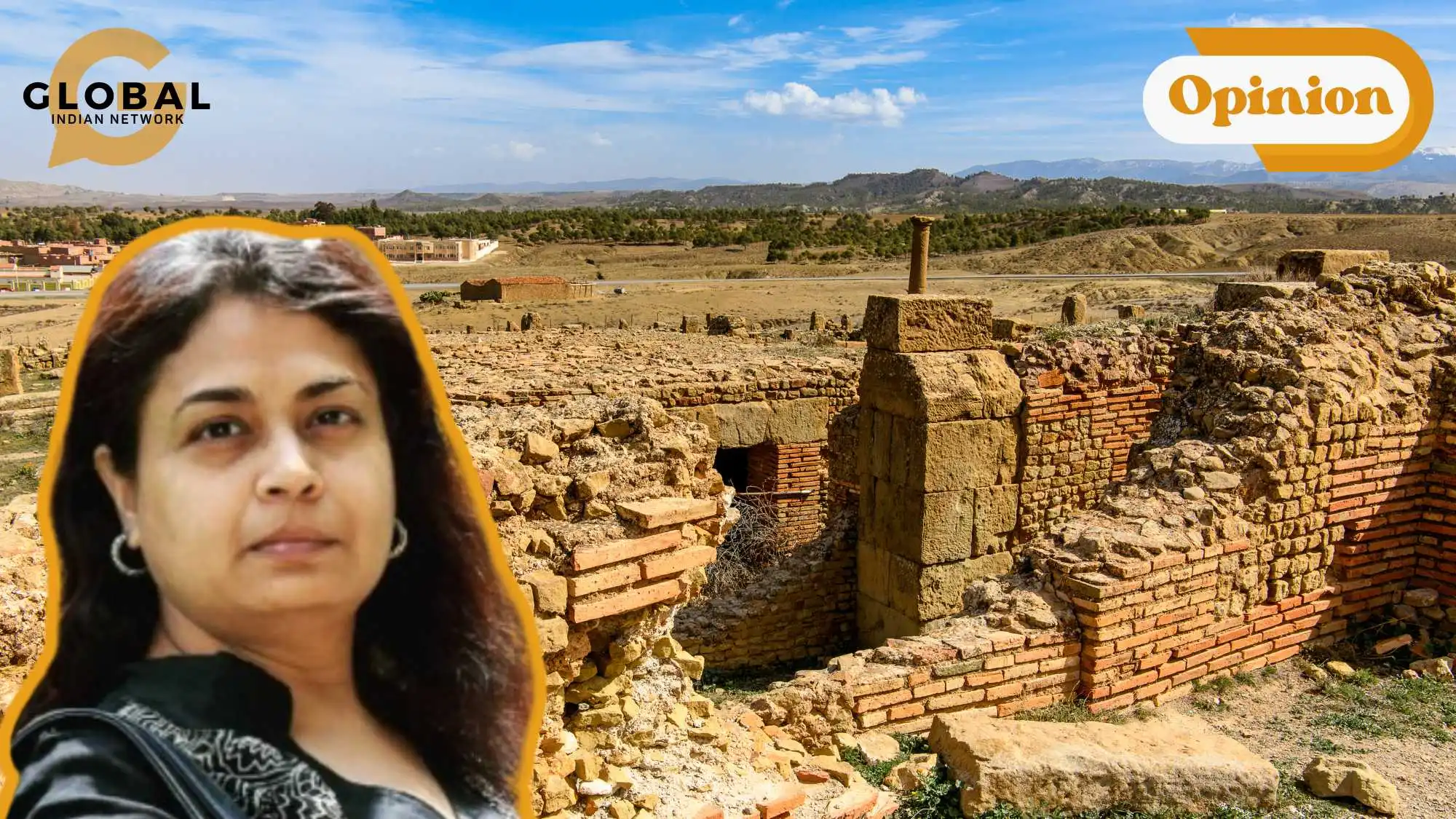Prehistoric Indian architecture refers to architectural developments in the Indian subcontinent before written history. It consisted of simple structures made from wood, thatch, and mud. Locally available materials were used, and cave architecture, such as rock-cut cave temples, was prominent. There were no grand temples or monumental structures. Artistic expressions were seen through cave paintings and carvings. Our knowledge is based on archaeological findings and cave sites, which laid the foundation for India’s architectural heritage.
Indian Architecture: Timeline in History
This period includes the Indus Valley Civilization, which dates to 2500 BCE. The architecture of this period was primarily made of wood and mud, which did not survive due to rotting and instability in the structures. However, the earliest existing Indian architecture was made with Indian rock-cut architecture, including many Buddhist, Hindu, and Jain temples.
Timeline source: wikipedia.org (text boxes in blue added by the author)
Extent

Extent of the Indus Valley Civilization
Rock-Cut Architecture
Prehistoric Indian architecture dates back to the Indus Valley Civilization, but most of the structures from that period, made of wood and mud, did not survive. However, the earliest existing Indian architecture is rock-cut architecture, seen in Buddhist, Hindu, and Jain temples. Rock-cut architecture involves carving into natural rock formations to create structures. The Ajanta Caves in Maharashtra are a famous example of rock-cut architecture. Indian architecture of this period featured intricate carvings and sculptures depicting scenes from Hindu mythology. Stone construction became more prevalent during the medieval period, using techniques such as arches, domes, slabs, and beams.
Architecture
The architecture of a place or a region is an outcome of the following:
- Geography and Topography
- Topography
- Climate
- Religion
- Socio-political Premise
- Technology
Geography and Topography
The Indus Valley Civilization, also known as the Harappan Civilization, thrived from 3300 BCE to 1300 BCE in South Asia. It encompassed the alluvial plain of the Indus River in present-day Pakistan and the Ghaggar-Hakra river system in northwest India and eastern Pakistan. The region was surrounded by mountains, desert, and the ocean, with dense forests and swamps to the east. The River Indus formed the local topographic baseline, with surrounding mountains reaching heights up to 5500 m above sea level. Glacial and glacio-fluvial valleys were present to the north of the study region.
Climate
The climate of the Indus Valley has changed over time, and a study by the Woods Hole Oceanographic Institution suggests that climate change caused the Harappans to resettle far from the floodplains of the Indus. Starting around 2500 BCE, a shift in temperatures and weather patterns caused summer monsoon rains to dry up, making agriculture difficult or impossible near Harappan cities. The current climate in the Indus Valley is semi-arid and watered by winter rains, seasonal streams, and human landscaping.
Religion
Many writers have focused on finding antecedents to the religious practices and deities of much later Indian religions, with the religion and belief system of the Indus Valley Civilization people attracting a great deal of attention. However, the evidence is so scant and subject to different interpretations, and because the Indus script is still untranslated, the conclusions are somewhat conjectural and mainly grounded in a retrospective analysis from a much later Hindu perspective.
John Marshall’s 1931 study, which was one of the first and most significant in the field, recognised the following aspects of the Indus religion as central to the Hindu interpretation of the archaeological evidence from the Harappan sites: the deification of a Mother Goddess and a Great Male God.



Terracotta and bronze figurine (Image source: wikipedia.org)
The Indus-Valley culture is believed to have faith in animism (a belief system that attributes living souls to plants, inanimate objects, and natural phenomena). It is believed that objects, places, and living beings all have a distinct spiritual essence. Animism sees everything—animals, plants, rocks, rivers, weather systems, human work, and, in some cases, words—as alive and vibrant. Animism focuses on the metaphysical universe, more precisely, the concept of the immaterial soul. Although each culture has its own myths and rituals, animism describes the most basic and common theme of indigenous people’s “spiritual” or “supernatural” outlook.



Animism followed. Some of these artefacts are displayed in other countries (Image source: wikipedia.org)
Socio-Political Premise
The political organisation of the Indus Valley Civilization is poorly understood, as there are no inscriptions recording their administrative structure. However, it is believed that administrators, merchants, and clergy all stood at the top of the pyramid of Harappan society. The creation of a centralised decision-making mechanism called a state was related to the development of civilisation. The construction of planned towns and roads, drainage systems, organised commerce, and the regularity of measurements and weights demonstrated the existence of a powerful centralised administration. In Harappan culture, there was a decision-making body to run the city’s system. Municipal city agencies had to build and maintain extensive road and drainage systems.



Trade between Mesopotamia and Indus Valley, archaeological remains (Image source: wikipedia.org)
Technology
The Indus Valley civilisation was known for its technological advancements. The people of the ancient Indus Valley developed new craft techniques, such as carnelian products and seal carving, as well as the metallurgy of copper, brass, lead, and tin. Indus River cities are known for their town planning, adobe houses, complex drainage systems, water supply systems, and large clusters of non-residential buildings. The civilisation also has standardised weights and measures.



Weights, weighing scale, and carnelian beads (Image source: wikipedia.org)



Terracotta and bronze figurine (Image source: wikipedia.org)

The Indus script has not been deciphered so far. (Image source: dkfindout.com)
Architecture
The houses of the Indus Valley Civilization were made of mud bricks, which were made by mixing mud with straw and then drying it in the sun. The houses are built around a central courtyard and have flat roofs made of earth and wood. The walls are thick and insulated. Houses have many rooms and usually have two or three floors. The cities of the Indus Valley Civilization were also famous for their advanced urban planning, with gridded streets and public buildings such as granaries, baths, and halls.

By Nizil Shah at English Wikipedia, CC BY-SA 3.0

Houses in the Indus Valley Civilization (Image source: tonsoffacts.com)

Public bath in the Indus Valley Civilization (Image source: tonsoffacts.com)

City in the Indus Valley Civilization (Image source: tonsoffacts.com)
End of the Civilisation

End of the Indus Valley Civilization (Image source: worldhistory.org)
The Indus Valley Civilization began to decline between c. 1900 and c. 1500 BCE, most likely due to climate change, though the reasons for its fall are still debated. (Source: worldhistory.org)
Summary
The Indus Valley civilisation laid the foundation for future developments in Indian architecture. The manner in which the framework for later architecture and architectonics unfolded is a tribute to the imagination and innovation of the old civilisation. Even in contemporary times, thousands of years later, both curious and serious visitors throng the site and let their imaginations loose. That is a legacy that all cultures aim to leave, and Indus Valley has been a success to the hilt.
Let us know what you think in the comment section below. If you want us to publish your opinion piece, mail it to us at larra@globalindiannetwork.com.









